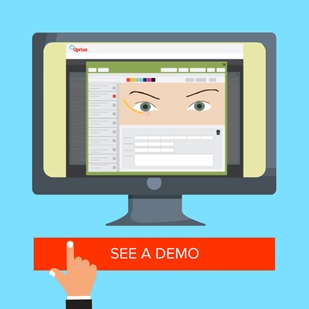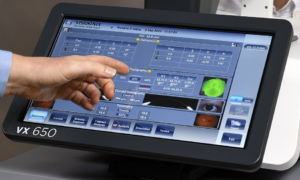Sponsored Content

By Matt Stanley, OD
May 17, 2017
When I bought my practice in 2008, I knew one thing I wanted my practice to be was modern and high-tech. I wanted patients to be wowed, and my workflow to be efficient. I wanted to ensure that our patients knew it was our goal to provide them with the most advanced eye health and vision care in our area. As a self-admitted tech geek, I also wanted to make optometry fun and exciting for myself and my staff.
Over the years, we have invested in an anterior segment photography system, some of the most advanced refractive data-gathering systems on the market, digital phoropters, an OCT with anterior and posterior segment imaging capability, widefield retinal imaging with autofluorescence, large monitors to share our diagnostic images and educational videos with patients, and even a digital imaging system in our dispensary so that we can more accurately obtain frame measurements and progressive fitting heights.
These things were working well for us, but when it came time for me to document patient examination findings, assessments, treatment plans, and interpretations and reports, and for my staff to import the wealth of data that came from all of our instruments, we realized our practice management and EHR system was holding us back from being that modern, efficient practice we had set out to be.
It was elongating our examination times, and forcing me to do most of my charting after the patient had left. Most importantly, I was spending too much time working on the patient record, and not enough time interacting with the patient.

Click HERE or on the image to demo Uprise, the practice management and EHR system that has enabled Dr. Stanley to see three additional patients per day
Vet Systems
I knew I owed it to my patients–and myself–to shop around for a more modern and efficient software solution.
My current system was an in-house server based system that wasn’t intuitive or easy to learn.
Having an intuitive, easy-to-learn system was especially important to me because my practice experiences slightly higher-than-average staff turnover. I practice in a college town and very close to a military base, both contributing to a transient population of working age individuals. New employees were experiencing a steep learning curve getting up to speed with our old software system.
Because of these pain points there were a few things that were most important to me in a new practice management and EHR software:
• User-friendly experience so new staff could jump in easily
• Cloud-based technology to relieve me from IT and security hassles
• All-in-one software so I could ditch costly and fragile integrated add-ons
• Efficient patient workflow and charting capabilities for faster exams
How the Right System Helped Me Shave Time Off My Day
With my client-server system, I was spending an extra 30 minutes a night backing up data. Plus, when a software update was released I was spending my free time on the weekend updating all 14 computers in the office.
Switching to a new, cloud-based practice management and EHR solution was a no-brainer, and has saved me significant time on IT maintenance and money that I was investing in an IT consultant. My new system also comes with patient recall, patient education, code verification, frame catalogs and e-prescribing. Not only can I access each of those features all from within the system, but I’m not paying extra money every month on separate contracts like I was before – it’s all built in. One system, one bill.
The system itself is visually appealing and fits the high-tech feel of our office. Our instrumentation integrates with the software, the patient can use the patient portal to submit their health history and review of systems, and the electronic prescribing is bi-directional – supporting importation of medications and dosages, eliminating a ton of data entry.
I expected an increase in efficiency, but what I wasn’t expecting was to save so much time that I was able to add three new appointment slots to each day within a month of implementing the new system. I knew my old system was slowing me down, but I wasn’t expecting a new solution to have such a quick and positive impact on my schedule, and of course, my revenue.
The new software has had a much quicker learning curve for my staff. Because it’s all-inclusive, the different parts of the software all talk to each other, from scheduling and insurance benefit retrieval, to check-in, to the exam documentation and coding, to optical and contact lenses, to checkout, to order placement, to insurance claim creation and filing, and finally, to ERA posting – it has minimized data entry tasks for everyone. With my old system, I would have to open multiple tabs and windows to access everything I needed for one patient, and now I have everything I need right where I need it.
A year into using my new practice management and EHR system, I’m glad we made the choice we did. Regular updates to the system are consistent with new features on each release that make the system even more efficient than it was before. I finally feel like my practice software works for my patients and me, instead of coming between us.
Get a look at the system that changed my practice, and REQUEST A DEMO to see it for yourself.
 Matt Stanley, OD, is the owner of Eye Care Associates of Manhattan, P.A. in Manhattan, Kan. To contact him: mstanleyod@gmail.com
Matt Stanley, OD, is the owner of Eye Care Associates of Manhattan, P.A. in Manhattan, Kan. To contact him: mstanleyod@gmail.com



























